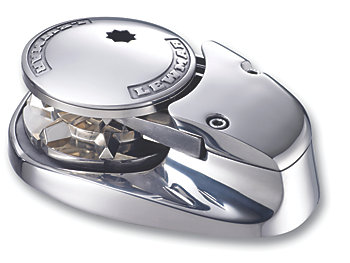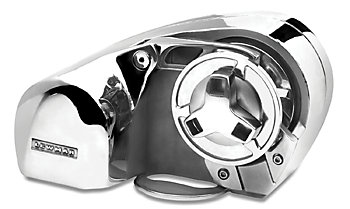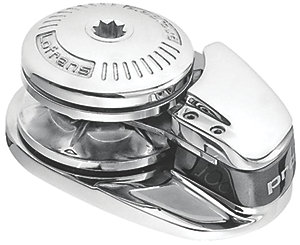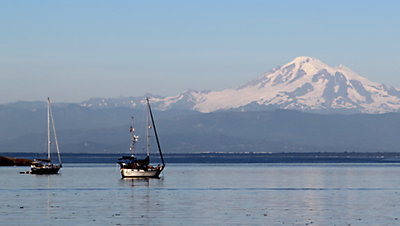Selecting an Anchor Windlass

What size windlass should I choose?
Choosing the right size windlass for your boat is crucial. Consider factors such as boat length, anchor size, and rope/chain requirements. While windlasses are marketed for a range of boat lengths, certain situations may require a larger capacity. Even with best practices, your anchor windlass may be tasked with heavy-duty operations.
To cover as many situations as possible, below we list factors you should consider in the process of deciding which anchor windlass to choose.
- Anchor Size – How much does your anchor weigh? It takes a lot more power to pull up a 75-pound anchor than a 30-pound anchor.
- Rode – How much chain or rope is connected to your anchor, and how much does it weigh? The higher the answer, the more power you'll need to retrieve it.
- Vessel Displacement – Is your boat fiberglass, steel, or maybe even ferro-cement? In rough conditions, the weight of your boat can easily be a factor in how much power you need when deploying or retrieving your anchor,
- Vessel Windage – A boat with a high cabin, large dodger, or a tuna tower will have far more windage (surface area exposed to the wind) than a boat with a flush deck. When retrieving your anchor, especially on a windy day, high windage will significantly increase the load on your gear, so you should definitely consider the potential benefits of upsizing if you have a boat with a lot of windage.
In general, the best method to figure out how much “pulling power” you need is to add up how much your ground tackle weighs (anchor, chain and/or rope) when not under load and then choose a windlass rated with a “pulling power” of at least 3 times that weight.
For example, let's say you have a 55-pound Rocna anchor with 150 feet of 3/8" HT chain and another 200 feet of 5/8" 3-strand nylon rope. The total weight of the anchor and ground tackle is approximately 305 pounds. To handle this weight, you'll need at least 915 pounds of pulling power (weight of the anchor and ground tackle x 3). If you have a heavy boat or high windage, consider upsizing your windlass. Remember, stronger is always better, and it will help your windlass last longer if it's not constantly pushed to its limit.
Horizontal or Vertical?

Horizontal windlasses have a more "traditional" look and are entirely above deck. They offer easier maintenance due to their visibility, but they take up deck space and can make bow work slightly more awkward. Surface mounting allows for easier installation and prevents the motor from occupying valuable space in small or shallow chain lockers.
The anchor chain engages only about ¼ of the chain wheel (gypsy) circumference on horizontal windlasses, making a good match of the chain size to the chainwheel, also known as the gypsy or wildcat, particularly important. A minimum "fall" from the gypsy to the top of the piled-up rode of at least 12" is recommended in order to have enough weight to pull the rode down into the locker. If a portion of your rode is rope, more fall is better. Horizontal windlasses with notches in the gear wheel can also be somewhat more forgiving than vertical models if the anchor/bow roller is located higher than the windlass chain wheel and can properly engage the links of the chain – such as out on a sailboat bowsprit.
Vertical windlasses
typically have their motor below deck, often presenting a sleeker "low profile" appearance. While the motor and gearbox are protected
from the elements below deck, they are potentially located in a relatively damp and salty environment – which can
increase the chances of corrosion. 
A minimum "fall" of at least 18" from the underside of the deck to the top of the piled-up rode in the chain locker is recommended to have enough weight to pull the rode forward from the chain wheel down into the locker. The anchor chain engages approximately ½ of the circumference of the gypsy, giving optimal chain control and minimizing jumping. While a vertical windlass is more suitable for boats with larger, deeper chain lockers, you may need to hire an expert to assist with the installation since they are fitted through the deck.
Both horizontal and vertical windlasses are typically available with or without a capstan drum for independent hauling of a second rode, halyard, tow rope, etc. As you can probably tell, both models have their pros and cons, including the use of a crank, so it is more likely that your boat's configuration and anchor locker will determine which one will work best.
Manual, Hydraulic or Electric?
The final thing to consider is whether you want a powered or manual anchor windlass – and if you go powered, should it be electric (DC) or hydraulic?
- Manual – if you have a smaller boat without a lot of battery power but just want some help getting the anchor up in windy conditions, a manual windlass may be a good option. They use zero electrical power (being completely human-powered), but give you a better mechanical advantage than retrieving the anchor by hand – which will save your back in the long run. They are available in two types – one uses a circular motion (similar to a winch), and one uses a back-and-forth motion (like a pump or lever). Similar to a winch, the circular model may come with the option for a second speed – which is extremely helpful when you need a little more power.
- Electric – these are the most popular option for boaters because of the ease of installation and the ability to retrieve your anchor with the push of a button or flip of a switch. But the electric windlass is only as good as the battery that runs it, so make sure you have enough power to complete the job! This usually will entail installing a dedicated battery for the windlass since the distance between the bow and the battery bank is likely too long of a wire run to meet the power demands of the windlass.
- Hydraulic – while this is the most complex option to install, it can offer constant power no matter how long you need it without worrying about running down your batteries – with the caveat that you need to run your main engine in order to power the windlass. That said, if you don't already have hydraulics on your boat, we highly recommend you consult with a professional before making any decisions.

Fisheries Supply stocks a wide variety of anchor windlasses from all the best manufacturers, including Lewmar, Lofrans, Maxwell, Muir, Powerwinch, Quick , and Vetus. We also carry a range of windlass accessories to complete your setup. We hope this Navigator has helped you understand what you need to know when choosing a new windlass anchor, whether it be a manual, hydraulic, or electric anchoring system. This includes understanding the different types of controls, such as a panel-mounted switch for remote operation from the helm, flying bridge, or cockpit.
If you have additional questions, please don't hesitate to contact our product experts at (800) 426-6930. For additional information on windlass operation, check out our Navigator on Using Your Windlass